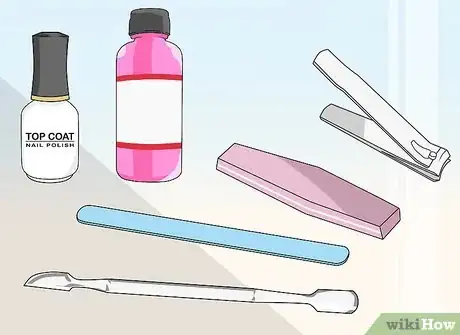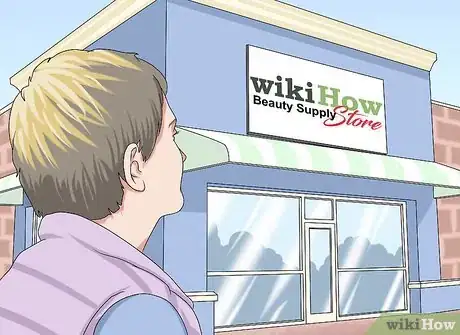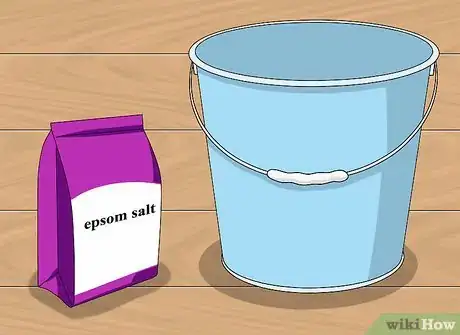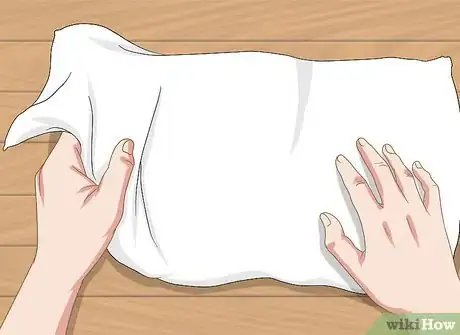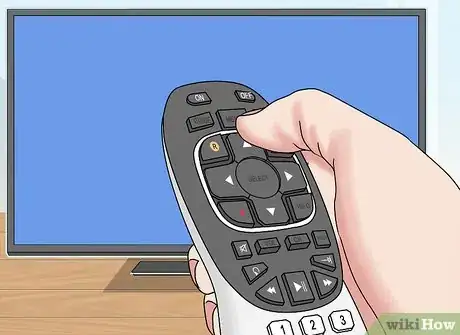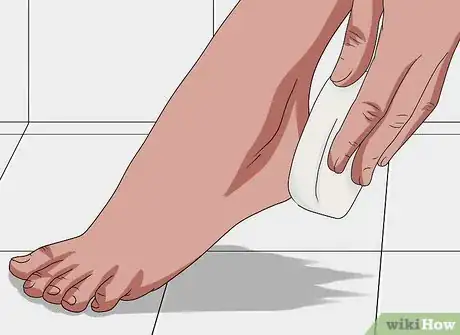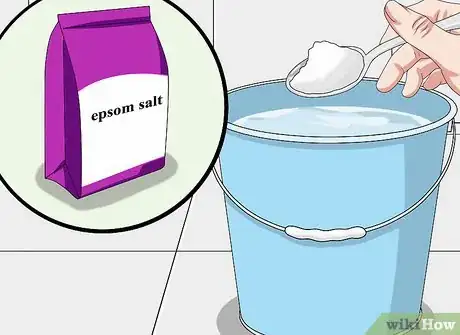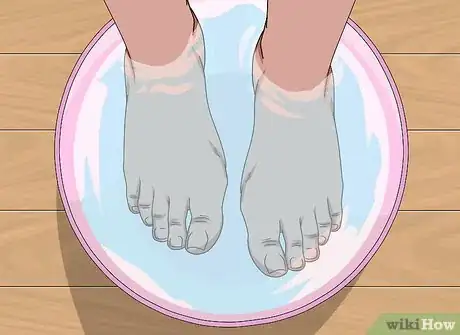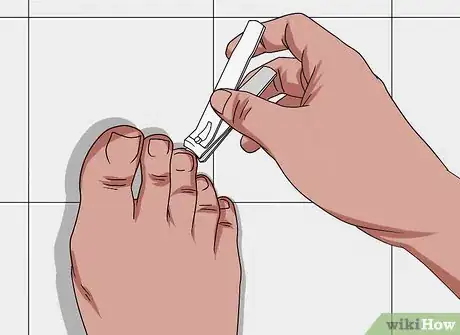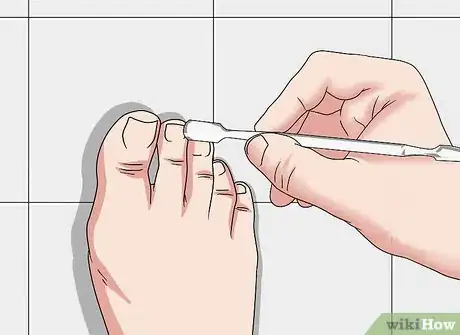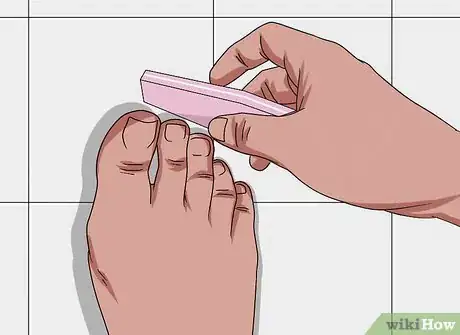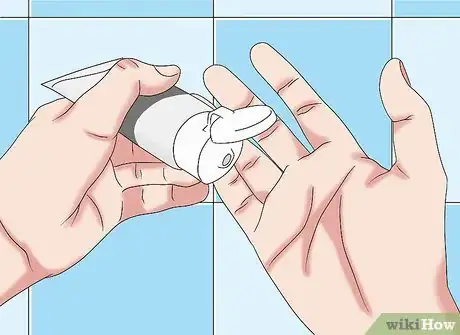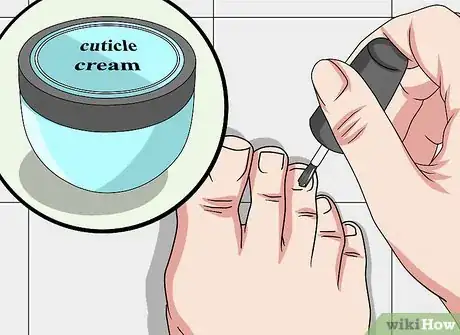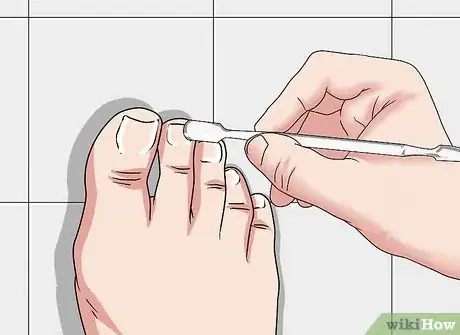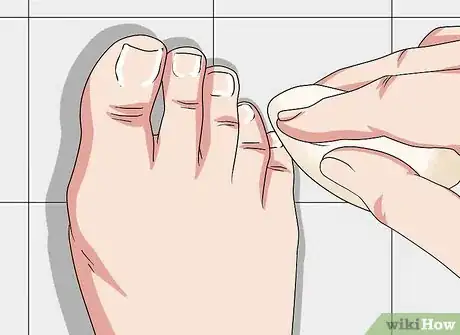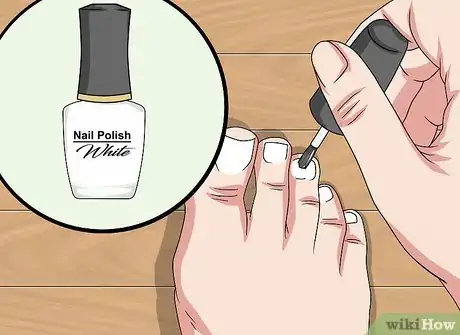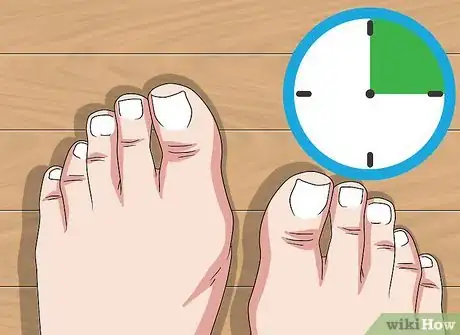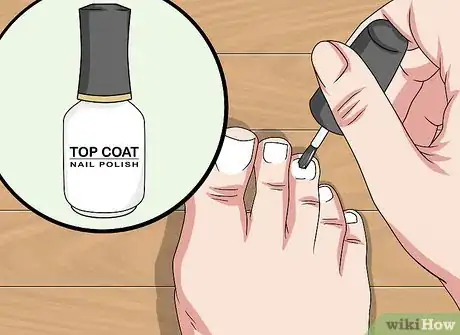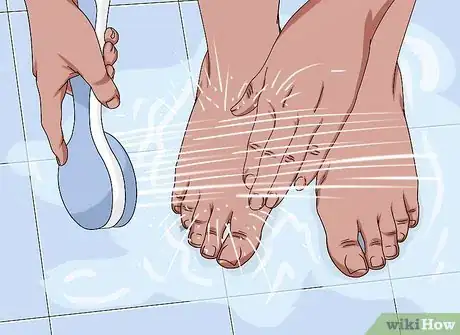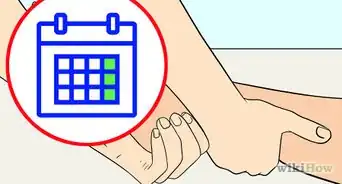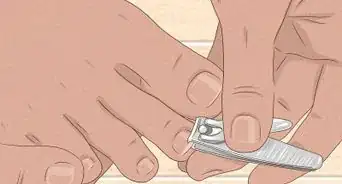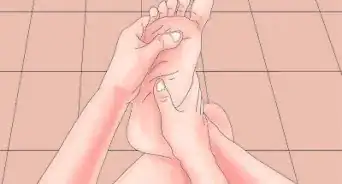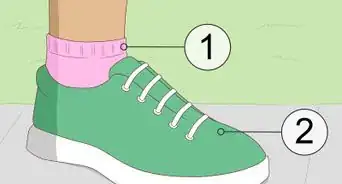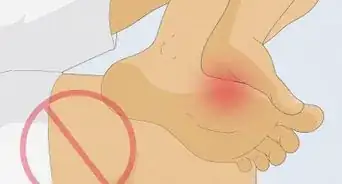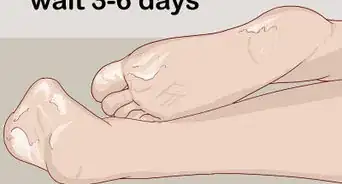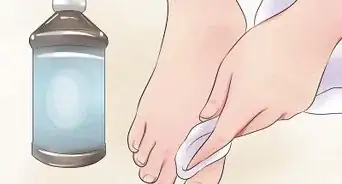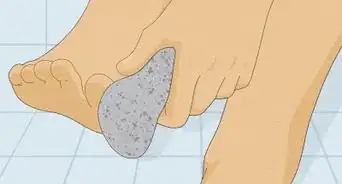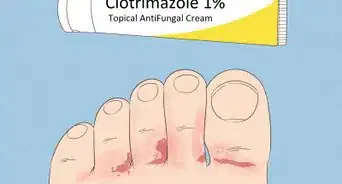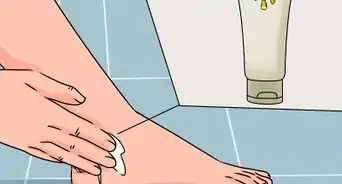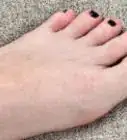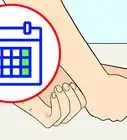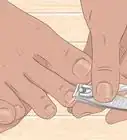This article was co-authored by Marta Nagorska. Marta Nagorska is a Nail Technician and Nail Art Blogger based in London, UK. She runs the blog, Furious Filer, where she gives tutorials on nail care and advanced nail art. She has been practicing nail art for over 5 years and graduated from Northampton College with distinction with a Nail Technician and Manicurist degree in 2017. She has been awarded the top spot in the OPI Nail Art Competition.
There are 9 references cited in this article, which can be found at the bottom of the page.
wikiHow marks an article as reader-approved once it receives enough positive feedback. In this case, 89% of readers who voted found the article helpful, earning it our reader-approved status.
This article has been viewed 131,212 times.
Having attractive feet is a universal desire. Whether you are a male or female, young or old, attractive, neat, and clean feet are preferable to gnarly, painful, unkempt ones. The high cost of salon pedicures can mean trying to hide your feet in socks or closed-toe shoes for months until you can afford to get to the salon. Happily, there are simple steps to giving yourself an at-home pedicure: preparing supplies, cleaning up your feet, and polishing them off.
Steps
Preparing Supplies
-
1Take inventory of what you already own. If you are familiar to at-home spa treatments, you may already have some of the necessary supplies on hand. Check your cupboards for epsom salts, nail clippers, an emery board, a cuticle pusher, a file (or pumice stone), cuticle cream, toe separators, nail polish remover and nail polish.
- Although not all of these tools are absolutely required, having all of them will result in a salon-finish at-home pedicure, rather than an amateur one.
-
2Go to a beauty supply store. If you are lacking any of the above ingredients, visit your local beauty supply store and pick them up. Talk with the store clerks and ask which tools are best for at-home use versus salon use.
- Some manicure and pedicure kits are designed for professionals, and will contain tools you will likely not use. Purchase the basic needs for your at-home pedicure, leaving salon-grade tools to the professionals.
- Do not assume cheaper means better; although you do not need a set of professional pedicure set, you do not want a set that is flimsy, either. Test the strength of the tools, and make sure the metal is thick enough to resist bending.
Advertisement -
3Grab a clean bucket and some epsom salts. Purchase a clean bucket, if necessary, and some epsom salts for soaking your feet. Although you can use many things in the place of epsom salts, such as magnesium and specialized foot soaks, epsom salts are inexpensive, relaxing, and effective.
- Ideally, use a bucket that can house both of your feet simultaneously. Although you can soak one foot at a time, soaking both feet at the same time will be more comfortable and will make the process go by more quickly.
-
4Lay down some towels. Before you begin your pedicure, lay down a towel or two to catch any stray water, and to dry off your feet after your soak. Have an extra hand towel and old rag at the ready in case of spills or polish mishaps.
- If possible, do your pedicure on a hard surface, such as tile or linoleum, as these are water-resistant. If you are working on carpet or wood, clean up any spills quickly.
- Choose towels you don't mind getting dirty or worn down. Although you will want to avoid a spill of any of your ingredients, they do happen, and both nail polish and nail polish remover stain fabric.
-
5Grab your favorite CD, book, or TV show. At-home pedicures can involve 10-30 minutes of downtime. Grab a book, turn on some music, or turn on your favorite show to keep your mind engaged while you soak and clean.
- If you struggle to multitask, put in some classical music to avoid cutting your nails too short or spilling your ingredients.
Cleaning Your Feet
-
1Scrub hardened calluses or dry patches. You can use a body brush for this, or a specialized tool, such as a Ped Egg or pumice stone. Keep your foot over the water as you scrub, as some skin may fall to the ground. Pay particular attention to your heels and the edges of your big toes, as these are the most common hiding places for calluses and dead skin.[1]
- Do not scrub until you feel pain; the idea is to remove dead skin, not still-living tissue. If you begin to feel pain or discomfort, you have removed the dead skin, and should move on to the next area.
- While you may prefer to soak your feet first and scrub second, most callus removal tools are designed to be used on dry skin. If you choose to soak first, make sure your feet are completely dry before scrubbing.
-
2Place hot water and salts into your bucket. The bucket you use can be a cleaning bucket, or a foot spa specifically designed for soaking your feet--either one will work fine. Fill your bucket with hot water and salts, and allow the salts to dissolve.[2]
- If you'd like a more relaxing foot bath, you can include a few drops of lavender or cedarwood oil, both of which are used to induce relaxation and may have antibacterial properties.
-
3Place one or both feet into the saltwater mixture. Place your feet (or one foot at a time, if space does not permit both feet) into the bucket, and set a timer for 5-10 minutes, according to your preference.[3]
- If you must do one foot at a time, be sure to complete the soaking and cleaning process entirely on one side before moving to the next.
-
4Clip your nails. Clip your nails straight across to prevent the risk of ingrown toenails. Although you may be tempted to follow the natural curve of your nail, you run the risk of cutting too short, or encouraging nails to grow inward rather than outward.
- Make sure your clippers are not dull, as using dull clippers can also encourage ingrown toenails. If you find it difficult to cut through your nail, sharpen your clippers.
-
5Clean any remaining dirt or grime from underneath your toes. Clipping your nails will likely remove some of the dirt and buildup deposited there, but you may still have some grime to remove. Clean your nails with soapy water (or the water from your soaking basin), until you no longer see any dirt or debris, and your nails are clean and light in color.[4]
-
6File the edges of your nails. Doing so will also minimize the risk of ingrown nails, and will give a smooth, rounded edge to otherwise-sharp nails. It seems small, but do not skip this step. Sharp, bumpy edges can lead to discomfort, as well as make the application of polish more difficult.[5]
- Opt for a 180- or 240-grit nail file since they're more gentle and you won't be as likely to split a nail.[6]
-
7Apply lotion to your newly-cleaned feet. Gently dry your feet with a towel, and apply oil or moisturizer to your feet, ankles, and calves. This is not the time for a quick run-over with lotion; instead, take the time to really massage your legs and feet.[7]
- If your feet are naturally dry, use a thicker lotion or oil, such as olive oil. This will help seal in moisture and ward off calluses and dead skin buildup. If your feet are naturally oily or moist, a thin lotion or lighter oil such as coconut oil will be a better fit.
Applying Cream and Polish
-
1Apply cuticle cream to your cuticles.[8] Dab cuticle cream into the cuticles of all five of your toes. Start with one foot, then move to the other, and allow the cream to rest for 2-5 minutes, or as indicated by your particular brand's instructions.[9]
- Again, this is an important step. Failing to soften your cuticles with cream before pushing them down could result in tearing or otherwise damaging your nail and cuticle. Be sure to properly moisturize before working on your cuticles.
-
2Gently push down on your cuticles.[10] After the cream has softened your cuticles, take your cuticle pusher and gently begin to press down, bringing your cuticles to the same level as the bottom of your nail.
-
3Dry your toenails. Remove any remaining lotion or cuticle cream, as both will interfere with the application of your polish. If need be, dip a rag into the epsom salt mixture and wipe your nails down first, to give the polish a dry, clean surface to grip.
-
4Apply nail polish. Separate your toes using a toe separator or rag to make application easier. Beginning in the middle of your nail, apply long, soft strokes to your nail, gradually moving outward, until all of the nail is covered. Move on to the next nail, allowing nails to dry fully before applying a second coat.[11]
- Follow this pattern on each of your nails, no matter how small. Using this technique provides an even all-over application, and will prevent streaking and clumping.
-
5Dry your nails. Once you have applied all coats, dry your nails using a specially-designed light, a hair dryer, or the most common method: letting your nails air dry for 10-20 minutes, or until the polish is no longer tacky to the touch.
- Letting your nails dry properly will mean the difference between a long-lasting pedicure, and one that flakes or chips within a few days. If you do not let your polish dry completely between coats or before your topcoat, your polish will be prone to smudging and scraping.
-
6Apply a topcoat. Apply a clear topcoat to keep color from chipping. If your nails are prone to breakage, apply a second layer after the first has dried. Swipe a thin strip over the top of your nail to seal in the tips of your nails and prevent chipping due to your nails striking against your shoes or floors.[12]
- Choose a thin, clear topcoat. A heavy topcoat will only add bulk and increase the likelihood of smudging. If you do add a second layer of topcoat, keep the brushstrokes thin and long, and wipe any excess off of the brush before applying.
-
7Maintain your pedicure. To keep your pedicure lasting longer, wash and moisturize your feet regularly. Use a gentle cleanser and cleansing tool to avoid chipping polish, and avoid salt soaks until your next pedicure; the salt in the soak can tear at your polish.
- If you shower daily, wash your feet daily and follow up with moisturizer. Even if you don't shower daily, clean and moisturize your feet each night.
Expert Q&A
-
QuestionHow do I give the best pedicure?
 Marta NagorskaMarta Nagorska is a Nail Technician and Nail Art Blogger based in London, UK. She runs the blog, Furious Filer, where she gives tutorials on nail care and advanced nail art. She has been practicing nail art for over 5 years and graduated from Northampton College with distinction with a Nail Technician and Manicurist degree in 2017. She has been awarded the top spot in the OPI Nail Art Competition.
Marta NagorskaMarta Nagorska is a Nail Technician and Nail Art Blogger based in London, UK. She runs the blog, Furious Filer, where she gives tutorials on nail care and advanced nail art. She has been practicing nail art for over 5 years and graduated from Northampton College with distinction with a Nail Technician and Manicurist degree in 2017. She has been awarded the top spot in the OPI Nail Art Competition.
Nail Artist Try doing a French pedicure by putting white nail polish on the end of each nail. Use a round brush dipped in nail polish remover to clean up the white tip on the inside of the nail so that the white line appears nice and round. Finally, apply a sheer pink on top so that the white is not too harsh, and follow with a top coat to make the polish last.
Try doing a French pedicure by putting white nail polish on the end of each nail. Use a round brush dipped in nail polish remover to clean up the white tip on the inside of the nail so that the white line appears nice and round. Finally, apply a sheer pink on top so that the white is not too harsh, and follow with a top coat to make the polish last. -
QuestionHow many times can I do this per week?
 Community AnswerYou can paint your toes as many times as you want. Make sure to put a base coat on if you plan on painting your nails a lot, or they might become discolored.
Community AnswerYou can paint your toes as many times as you want. Make sure to put a base coat on if you plan on painting your nails a lot, or they might become discolored. -
QuestionCan I use a razor blade as a foot file or to scrub my foot?
 Community AnswerDefinitely not. If you have a lot of hard skin on the underneath of your feet then you can use a specific corn and hard skin knife that has a guard to stop you from cutting your feet. To file your feet, use a proper foot file or pumice stone, these are really good at getting rid of thick skin gently.
Community AnswerDefinitely not. If you have a lot of hard skin on the underneath of your feet then you can use a specific corn and hard skin knife that has a guard to stop you from cutting your feet. To file your feet, use a proper foot file or pumice stone, these are really good at getting rid of thick skin gently.
Warnings
- Never share your nail tools without first sanitizing them thoroughly.⧼thumbs_response⧽
- Always use polish and polish remover in a well-ventilated area to prevent the inhalation of potentially harmful chemicals.⧼thumbs_response⧽
- Avoid buying used tools, if possible, as you cannot be sure of the item's origin.⧼thumbs_response⧽
Things You'll Need
- A tub for soaking
- Epsom or other foot soak
- Callus remover
- Nail clippers
- Emery board
- Towels and rags
- Toe separator
- Nail polish
- Nail polish remover
- Cuticle tools and cream
- Moisturiser
References
- ↑ http://www.telegraph.co.uk/beauty/hair-nails/how-to-do-a-proper-at-home-pedicure/
- ↑ https://www.canyonranch.com/blog/beauty/the-healing-benefits-of-foot-soaks/
- ↑ http://www.allure.com/story/6-steps-to-a-perfect-home-pedicure
- ↑ http://food.ndtv.com/beauty/pamper-your-feet-from-diy-pedicure-to-natural-home-remedies-1208041
- ↑ http://www.health.com/health/gallery/0,,20392057,00.html#cut-and-file-0
- ↑ Marta Nagorska. Nail Artist. Expert Interview. 29 July 2019.
- ↑ http://www.telegraph.co.uk/beauty/hair-nails/how-to-do-a-proper-at-home-pedicure/
- ↑ Marta Nagorska. Nail Artist. Expert Interview. 29 July 2019.
- ↑ https://explorecuriocity.org/Explore/ArticleId/171/what-are-the-benefits-of-using-cuticle-cream-171.aspx
- ↑ Marta Nagorska. Nail Artist. Expert Interview. 29 July 2019.
- ↑ http://www.health.com/health/gallery/0,,20392057,00.html/view-all#polish-to-perfection-0
- ↑ http://www.cosmopolitan.com/style-beauty/beauty/how-to/a5101/things-about-painting-your-nails-you-might-not-know/
About This Article
Doing a self pedicure at home is a great way to pamper yourself and save some money, and all you need are a few beauty supplies. Before you start, lay down some towels, and fill a clean bucket with Epsom salt and hot water, which you’ll use for a foot bath. Gently scrub any calluses or dry patches on your feet with a pumice stone. Then, place your feet in the bucket for 5-10 minutes to soak and soften your skin. Once you’re done soaking, clip your toenails and file them into a smooth, rounded edge. Dry your feet and apply some lotion to soften your skin. To finish your pedicure, apply whatever color nail polish you like. To learn how to help your pedicure last longer, read on!
